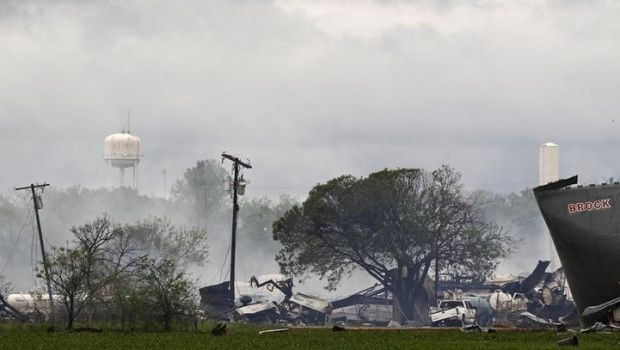Anhydrous Ammonia Fertilizer Isn't Normally Considered An Explosion Risk, So What Happened In West?

The horrific explosion at a West, Texas, fertilizer plant on Wednesday came from a more unlikely source than you might think. The chemical stored there is not generally considered as much of a fire or explosion risk as other nitrogen-based fertilizers. But it seems that under certain conditions, what’s been thought of as a safe chemical can turn deadly.
According to the Dallas News, the West Fertilizer Co. had as much as 54,000 pounds of anhydrous ammonia at its facility. The company noted in an emergency planning report that this kind of fertilizer is not considered an explosion risk in its gaseous form, though it can sometimes explode if kept contained at certain concentrations.
Some news outlets covering the explosion have been conflating anhydrous ammonia with a different kind of fertilizer called ammonium nitrate. But they’re completely different chemicals.
Anhydrous ammonia is made from three parts hydrogen to one part nitrogen. The “anhydrous” part of the name refers to the fact that there’s no water involved in the reaction that makes it. Ammonia was initially produced to make explosives but was repurposed as a fertilizer after World War I. Adding it to soil contributes nitrogen, a vital component needed for plant growth.
As a fertilizer, anhydrous ammonia is stored in tanks as a liquid under pressure -- without the added pressure, it would quickly boil into a gas -- and transported via pipeline, truck, rail or barge.
Anhydrous ammonia is considered safer to store in large quantities, because it takes extremely high temperatures to set it off. But it’s not totally harmless: Direct exposure to anhydrous ammonia can be seriously harmful, causing eye and skin irritation, respiratory problems and, at high concentrations, death.
Leaks of gaseous anhydrous ammonia are also dangerous. “Because the vapors hug the ground initially, the chances for humans to be exposed are greater than with other gases,” the U.S. Centers for Disease Control and Prevention says.
Ammonium nitrate, a combination of nitrogen, hydrogen and oxygen, is a lot more volatile, prone to combustion and reaction, thanks to the fact that it is a strong oxidant. (Anhydrous ammonia can be converted to ammonium nitrate using nitric acid.)
So what caused the explosion at the West plant? Something grimly ironic. City University of New York physicist Michio Kaku told CBS News that the water firemen were using to fight a routine fire may have set off a chain reaction of explosions.
“The [Environmental Protection Agency] regulations say it's OK to have this amount of material, because nothing's going to happen, but there's a rare sequence of events, the right pressure, temperature and right amount of water will set off anhydrous ammonia," Kaku told CBS.
There’s still the question of what set off the initial fire -- whether the company also stored some ammonium nitrate or whether there was some other source of combustion. The next few weeks of investigation may provide answers.
Some companies are trying to alter fertilizer to make it safer and more difficult to turn into a weapon. Chemical company Honeywell is making a patented compound called Sulf-N 26, a chemically fused combination of ammonium sulfate and ammonium nitrate. The former acts as a fire retardant, while the latter provides nitrogen to the soil. Honeywell says Sulf-N 26 is safer to store, transport and apply than anhydrous ammonia. You can see a side-by-side comparison of the Sulf-N 26 fertilizer and ammonium nitrate fertilizer burning here.
Chemically safer fertilizers could reduce the number of industrial accidents and may also thwart attempts to use fertilizer to make explosive devices. Two of the main components of the truck bomb used by Oklahoma City bomber Timothy McVeigh were ammonium nitrate and diesel fuel. Since the bombing, Congress has passed laws putting tighter restrictions on the buying and selling of ammonium nitrate.
© Copyright IBTimes 2025. All rights reserved.





















